#Worldbuilding Original Species
Explore tagged Tumblr posts
Link
Chapters: 7/20 Fandom: Star Trek: Alternate Original Series (Movies) Rating: Mature Warnings: Graphic Depictions Of Violence Relationships: James T. Kirk/Spock, James T. Kirk & Leonard "Bones" McCoy Characters: James T. Kirk, Spock (Star Trek), Leonard "Bones" McCoy, Nyota Uhura, Background & Cameo Characters Additional Tags: Insecure Spock (Star Trek), Pining James T. Kirk, Hanahaki Disease, Worldbuilding, Original Species, Sexuality Crisis, Matchmaker Spock Prime, Except this is Spock Secunde, The Next Universe in the Loop, Starfleet Academy, Starfleet Academy Era, James T. Kirk is a Mess, Half-Human, Star Trek needs more militant xenophiles so I obliged, Pon Farr, Slow Burn, Yes I can have both of those tags just watch me do it, Vulcan is Not Destroyed, Everybody Lives, POV James T. Kirk, POV Spock (Star Trek), T'hy'la, Drama & Romance, Fix-It, I said slow burn Spock what are you doing?, stop planning a wedding with your parents before you've even confirmed that Jim's your boyfriend Series: Part 2 of Infinite Combinations of Spiral Diversity Summary:
Spock has worried over this task for a lifetime, and came up with a failsafe that might just save the Vulcan that exists in the next universe. The failsafe also involves deeply selfish things, but you can't fault an old man for wanting the youth to have more opportunities than he ever could.
He sends drones ahead of him into the black hole, hoping that the automated programming he coded into them will change the past for the better.
Mostly a romantic academy-era drama until a world is ending and they need to stop it from the point of view of the younger Spock and Jim Kirk.
Or: If Jim Kirk can cheat his way out of a no-win simulation with some code, Spock can do it in real life with some time travel.
#Insecure Spock (Star Trek)#Pining James T. Kirk#Worldbuilding Original Species#sexuality crisis#aos spirk#james t. kirk/spock#pon farr#slow burn#yes I can have both of those tags watch me do it#vulcan is not destroyed#fix it fic#fanfiction#starfleet academy era#Star Trek needs more militant xenophiles so I obliged#t'hy'la#drama and romance#I said Slow Burn Spock#What are you doing?#stop planning a wedding with your mom before you've confirmed that Jim is your boyfriend#Vulcan culture worldbuilding
8 notes
·
View notes
Text

You squint your eyes in the direction of the forest edge, between the shadows and the mist you see pale, humanoid shapes. It's not ghosts, not this time, but a herd of brynaglo. This nocturnal herbivore has an inquisitive but careful nature, listening with its large ears to anything that catches its interest before slowly and quietly approaching. It's not unusual for brynaglo to approach campsites in or close to the forest, often with terrifying effect on non locals.
9K notes
·
View notes
Photo
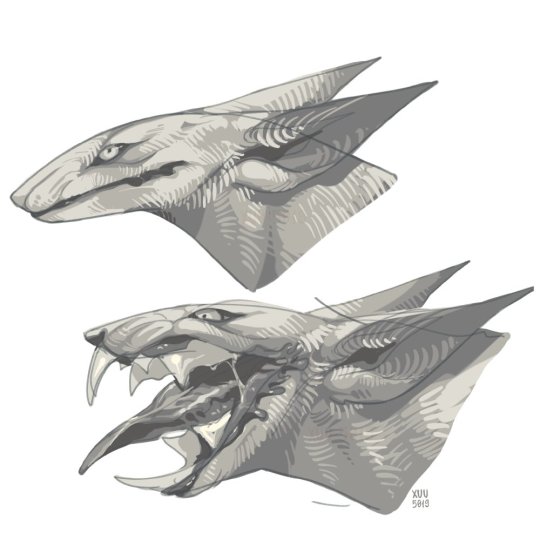
Meao-ixuí teeth concepts
#meao#meao-ixui#original species#species concept#artists on tumblr#brart#brartist#brazilian artist#maw#jaw#teeth#mouth#mouths#art#digital art#fantasy#fantasy art#worldbuilding#fictional species
21K notes
·
View notes
Text

i made her smooth
#hatsune miku#(shes not just a shark furry this is a species from a worldbuilding setting)#fibsharks#greyworld#anthro#myzo fibshark#my art#fanart#original species
985 notes
·
View notes
Text
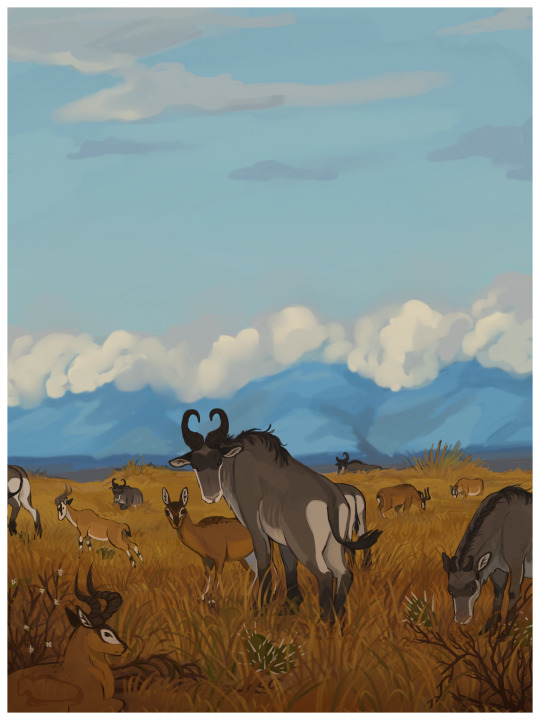
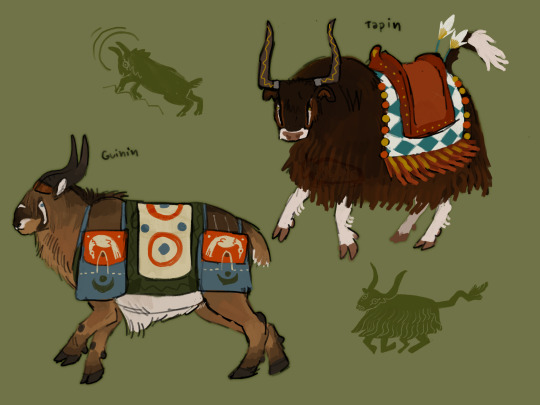
Some bovids of Lishel.
The western savanna is home to Keerso, Vans impala and, Tapper impalas. Keerso are one of the most populous animals in the area, leading to herds being domesticated for meat. Vans impala are seen as blessed animals, and killing them is looked down on.
The mountainous eastern coast is home Guinin, and Tapin. Both have been domesticated, wild populations still exist naturally. Guinin are often used in hauling due to their hefty builds. Tapin are fast, and sure footed. They can jump along tough terrain with ease and are often used for general transport. These species as historically important to the area.
#sokiin#illustration#worldbuilding#original species#speculative biology#concept art#spec bio#speculative zoology#spec evo#speculative evolution#bovidae#painting#ungulates
2K notes
·
View notes
Text

Kixeli head portrait!! Featuring from top to bottom:
The settled tidal flats people, the cliff divers, mangrove nomads, and islanders!! These are the majn grouos youd encounter. To their right are the Arasit version of these.
#alien species#original species#spec evo#worldbuilding#drawing#speculative biology#xenobiology#Kixeli
458 notes
·
View notes
Text

Uniima larvae come in large numbers but high mortality rate as these onigiri have to compete to become juveniles even in the egg case.
They start off with an egg wall. Their bodies are still clumbs of cells that slowly fill up the inside of the 'egg', consuming the included nutrients. Once they are ready, the baby grows it's own wall for the first time and 'hatches'.
After this the larvae molts as it grows with a new wall each time. During the whole larval period the shed skin sticks to the white. If adults don't clean them up, you will see multiple torn layers on top of the white, which can cause issues.
The white grows a straw. A somewhat brittle organ compared to that of ancestral larvae but functional enough to pierce under another whites wall (especially in the side seam). The larva actively feeds itself using this, though the food has to be liquid enough to get through the straw. They don't smell or see to search for food and will just wiggle the straw around until they can slurp. These triangles are mostly fat and liquids with other tissues in the center and thowards straw.
When they completely lose the straw (the entrance to it reforms), they start eating with their new mouth. At this point they also start making noise with their nostrils. Adult Uniima are sensitive to this much more than to the visual cuteness of the larva. This is often when adults start claming individuals to raise.
As the creature grows and gains complexity inside its own wall, it's new molts allow for use of more developed parts - anal cavity opens, ear cycles appear, eyes get bigger and closer to the wall surface, "mouth hands" with leathery pads emerge.. and lastly it's whole legs with fingers (often just silhouettes of feet show up rather then whole fingers or they are webbed).
After it's last stage and sufficient amounts of food, the white goes dormant to metamorphosise. This can take a week and less as most juvenile components are already in place.
The larval stages of Uniima can differ in length depending of environment - temperature, humidity, lack of food...
The average time from birth to metamorphosis is around 3 and half earth months.
The images here are not fully up to scale. Most larvae grow more between the stages but it's also not impossible for it to be to scale. I would just consider this larva a runt of the litter.
#art#speculative biology#digital art#uniigiri#artists on tumblr#artwork#worldbuilding#speculative evolution#spec bio#uniima#white#alienart#xenobiology#uniima larvae#alien life cycle#ask#original alien species#yummy food#some cultures will eat them at a growth stage yes#or just have them raw right away to regain energy
398 notes
·
View notes
Text

everyone say hi to Pancake :) nude vers under the cut lol
Ch-petta is part of a species of sophont whose home planet has been destroyed for at least 300 years - accounts vary. they were some of the earliest to reach space, though that was far before the destruction of their planet. they were the first to make contact with humans.
they make their homes in space stations and occupied planets willing to harbor them, and are a protected species due to low population. they are the founders of one of the largest intergalactic coalitions, whose aim is, for the most part, conservation - they are not, however, responsible for marking their species as protected. that was humanity. it goes without saying, they are quite welcome on earth.

in case you're wondering, i WILL be drawing more of these guys, because their anatomy i fear needs some explaining lmao
#my art#digital art#character design#original character#original species#spec bio#speculative biology#spec evo#worldbuilding#xenobiology#rausliers#paper aliens
367 notes
·
View notes
Text

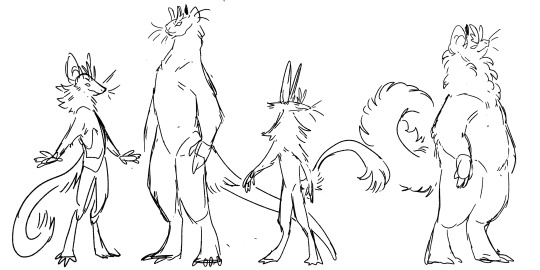
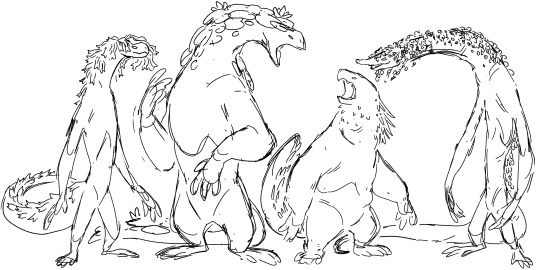
Body types for all the species in koegama :) they all have the potential to gain muscle and fat, just at different rates
#hanasei#luminae#tajira#art#koegama#speculative biology#worldbuilding#original species#specbio#koegama art
640 notes
·
View notes
Text

Industrial light ⚙
An experiment I made to see if I haven't forgotten how to make illustrations in my style.
Also it represents tovoxran cities' vibe and aesthetic (idk if it's cringe to use that word or not), basically steel beams, gears, metal scaffoldings and pipes everywhere. Just industrialism and utility.
The drawing itself is showing a heat generator in one of underground tovoxran cities on Tillturn (their homeworld). In the past they used to build their cities around active volcanoes or lava lakes for heat, because the whole cave system is cold, covered in ice and snow. Now they can build everywhere, as their technology allows that.
#myart#alien#alien species#original alien species#sci fi#science fiction#industrialism#illustration#speculative evolution#speculative biology#spec evo#spec bio#creature#creature design#worldbuilding#tovoxrans
826 notes
·
View notes
Text
Xa ontogeny

The Xa and how they grow. The brown-feathered kiddos past age of 1,5 are already able to fly somewhat. Xa don't show any sexual dimorphism, so there's only one Xa image for each life stage. Here's more about this sophont: https://www.tumblr.com/total-convergence/726112557515128832/tcxa
#speculative evolution#creature design#artists on tumblr#digital art#spec bio#spec evo#worldbuilding#speculative fiction#artwork#my art#art#reference sheet#bird art#small artist#digital artist#oc artist#drawing#illustration#scifi#scifi worldbuilding#imagination#oc art#oc#original species#speculative biology#bird oc#corvidae#magpie
383 notes
·
View notes
Text
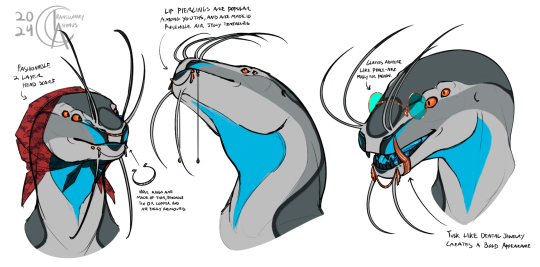
Temiraan shows off some popular youth fashion from their culture.* More under the cut.
Lip jewellry and other metal decorations are typically made from tin or copper, the two most abundant metals on their planet. They're fairly easy to heat and shape and contrast well against the dull backdrop of Chenesht skin.
Additionally, many pieces of jewellry from piercings to necklaces to bracelets, even some tassled cloaks and scarves, are meant to resemble the fluttery looking tendrils of the Helium Jellyfish ('air jellies') that serve as their primary predators. It's believed that wearing depictions of the air jellies confuses and wards them off, and on a more spiritual level, bestows confidence and bravery on those who wear them.
Dental jewelry is also particularly popular, especially lower jaw clasps meant to resemble large teeth or tusks. While primarily worn by youths to look fierce and tough, the actual tusks are often quite dull and cause minor bruising at best if they're on while roughousing. Fight appropriate tusks are typically made from bone and are much larger, attatching to a jaw guard or a helmet rather than a thin strip of metal on the lower jaw. There's also a third type of tusk meant for sport fighting, which is typically made of compact air jelly flesh, leading to a rubbery, non-harmful impact.
Head scarves and other coverings when worn by youth are typically sheer and decorated with bright colors and fun patterns. They're seen as a transitional fashion before adulthood, in which thicker, duller coverings become more common (especially among married adults). The sheer fabric allows more breatheability, and the customization and patterns allow more self-expression that adults typically display.
The Glasses Temiraan wears are mostly for fashion. Only the wealthy or particularly determined artisans ever purchase 'refocal lenses'. Also called 'detail lenses' or 'predator lenses', Refocal lenses allow Chenesht to see both far and near with clarity and focus on details. Glasses for fashion tend to focus more on shape and contrast rather than actually assisting the wearer with broadening their field of view.
The emphasis on bright colors, contrasting patterns, and bold shapes comes from the chenesht inability to see quite as many colors as humans can. Their color vision is limited, and they struggle seeing reds and greens properly, so the more contrast and vibrancy, the better.
[Image adjusted to Chenesht Vision]
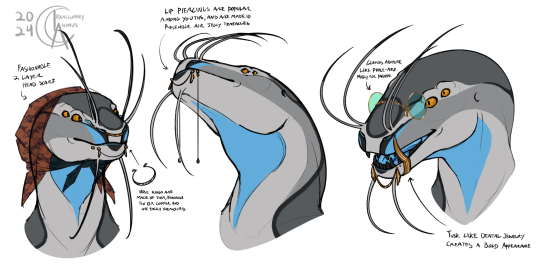
* Everything stated only applies to one of several Chenesht cultures. Everything here is also subject to change as I continue to develop Chenesht culture and society.
#digital art#arte#worldbuilding#setting: sacred estuaries#SE chenesht#temiraan#xenobiology#speculative biology#specbio#original alien character#original alien species#speculative fiction
152 notes
·
View notes
Text

As if "swallowed by the earth" is a way to describe someone who's gone missing without a trace, particularly in the woods, but in Ditovo it may be more than just a saying. At least if you believe the many legends and folktales about giant plumsaina, or as they're more commonly known "earth belly". The plant does exist but usually it is only big enough to catch small vertebrates, which it does when prey step onto its camouflaged trap door and fall into the pit of the plant filled with digestive liquid and downward pointing spikes preventing escape. The roots of the plant are for storing nutrients and other substances, as well as firmly anchoring the plant in the ground when prey is thrashing about inside it. In order to reproduce the earth belly sprouts a red flower above the surface, a red flag that may perhaps save the life of one who recognizes it.
#original species#worldbuilding#world building#plant design#fantasy species#fantasy plant#flora#cursed papaya looking spud
5K notes
·
View notes
Text


MORE. Baug Aliens.
Introducing Sterling Wasps, native hymenopterans of the Glass Sea Bed:
These wasps are variable in color, exoskeletons shifting from an obsidian black to a gleaming silvery sheen under direct sunlight.
Their unique physical make up serves as a way to reduce and reflect heat and harmful radiation while active during the day.
Sterling Wasp Colonies form deep burrows beneath the sand; Their caves often take on a crystalline form or patterning along the walls and ceilings
They are fast. Rivaling jet speeds, their wing beats carry them far across the scorching sandy surface to limit their time above ground. (Spectators observe Wasp activity as a glittering from a distance matching that of the sparkling sand.)
———
‘Ambassadors, looking for more information about special presentations or volunteer opportunities? Contact your local division leaders and bee involved!
Please also join us for the upcoming “Wings Over Seas” air show and festival for heart racing experiences! Food, Music, Aerial demonstrations, epic tournament sporting, immersive exhibits, and exclusive lectures held by our hymenopteran guest speakers (See details inside)’
- Excerpt from ‘Hive Society’ Springtime Ambassador Programs
#digital art#original character#character design#bug#insect#insect oc#bug oc#wasp#worldbuilding#alien#fantasy#monster girl#bug knight#original species#artists on tumblr#bug monster#concept art#art stuff#oc: Sterling Wasp
160 notes
·
View notes
Text


some outfit practice with fayons ^_^
#worldbuilding#fantasy worldbuilding#my art#illustration#spec evo#speculative biology#speculative evolution#original species#spec bio#sokiin
456 notes
·
View notes
Text

Some oldish drawings of the goobers. Go look at their ref!!
#alien species#original species#spec evo#worldbuilding#drawing#speculative biology#xenobiology#Kixeli
293 notes
·
View notes